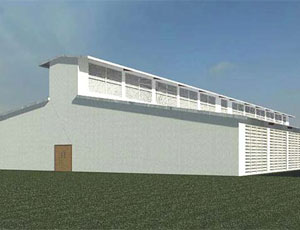...watt of power used to run the computer equipment an additional watt of power was required to cool the facilities, distribute power and take care of other ancillary power requirements.

Yahoo’s PUE of 1.08 implies that the average cost to cool the facility is less than one percent of the power required to run the servers and other IT equipment in the data center.
Beyond saving energy, eliminating traditional chiller based systems and cooling towers is saving enormous amounts of water. Noteboom estimates that during the summer the center will save 125,000 gallons of water a day. “We are also saving millions of gallons of sewer discharge.”
The design eliminates the need for raised floors. Instead the facility is built on a concrete slab. Electrical distribution is run overhead.
“A lot of Yahoo’s servers come pre-racked,” Deneny explains. “The data center is built in such a way that that whole server cabinets slide into place and then connect to an electrical bus that is overhead.”
Unlike traditional data centers constructed of precast concrete or steel and precast concrete, the Yahoo Computing Coop employs pre-engineered metal buildings. It is very economic from a cost perspective and pretty fast to construct on the site, Deneny says.
The design for the data center is part of the paradigm shift toward utility computing. “Everyone envisions that a data center has to be this mission critical machine that has to look a certain way,” Noteboom says.
“In essence the data center is going more utility,” he says. “It is going bigger scale, built more efficiently and at a lower cost. Instead of building a 5x9 datacenter and getting 5x9 performance [referring to standard service times] you build two 4x9 data centers in diverse areas. You end up with better up time. That speaks to the future of utility computing. I call it geographic replication functions.”
“They say you can’t get faster, cheaper and better at the same time,” Noteboom says. “In this particular phase of data center evolution you kind of can. And we are.”
Lockport beat out other locations for the new facility in part because of a deal negotiated with the New York Power Authority (NYPA) to supply 15 megawatts of low-cost hydroelectric power from NYPA’s Niagara Power Project. The town also offered a 20-year tax incentive that includes a 100 percent tax exemption for the 10 years.
In January the project won a $10 million grant from the U.S. Department of Energy. The award was part of $47 million in grant money allocated under the American Recovery and Reinvestment Act for the development of new technologies to improve the energy efficiency of the information technology sector.
The project is currently on track for completion in June. “Building in Buffalo during the winter is never an easy task,” Deneny says. “The subcontractors and vendors on the project are used to dealing with the weather and all aspects of the projects are coming together well.”


Post a comment to this article
Report Abusive Comment